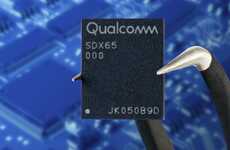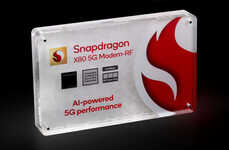
Telstra Demonstrated the World's Fastest LTE-A Networking Speeds
Rahul Kalvapalle — May 17, 2014 — Tech
References: telstra.au & gizmag
Australian telecommunications company Telstra claims to have demonstrated network speeds of 450 megabytes per second using an LTE-A network. LTE or 'Long Term Evolution' is better known as 4G, while the added 'A' means 'Advanced.'
Telstra used a combination of spectrum at 1800 and 2600 Megahertz using 'LTE Advanced Carrier Aggregation' technology. The resulting speeds are a ridiculous 8,000 times faster than the good-old 56 kilobytes-per-second modems we used to use as a recently as 15 years ago.
Despite the excitement generated by these results, deployment of this technology to customers remains a few years away and that the speeds achievable in practice will likely be lower than those achieved in Telstra's lab tests.
However, these results show that massive amounts of traffic demand can be shared across many users, which bodes well for the telecommunications industry going forward.
Telstra used a combination of spectrum at 1800 and 2600 Megahertz using 'LTE Advanced Carrier Aggregation' technology. The resulting speeds are a ridiculous 8,000 times faster than the good-old 56 kilobytes-per-second modems we used to use as a recently as 15 years ago.
Despite the excitement generated by these results, deployment of this technology to customers remains a few years away and that the speeds achievable in practice will likely be lower than those achieved in Telstra's lab tests.
However, these results show that massive amounts of traffic demand can be shared across many users, which bodes well for the telecommunications industry going forward.
Trend Themes
1. LTE Advanced Carrier Aggregation Technology - The use of LTE Advanced Carrier Aggregation technology to combine different spectrums creates an opportunity for network providers to offer faster data speeds.
2. Increased Speeds in Telecommunications Industry - The advent of 5G-compatible networks and the utilization of enhanced LTE technologies presents an opportunity for telecommunications companies to provide faster connectivity to customers.
3. Sharing Traffic Demand Across Users - Sharing traffic demand across multiple users utilizing LTE-A network technologies could reduce network congestion and improve data transfer speeds for all network users.
Industry Implications
1. Telecommunications Industry - The telecommunications industry can take advantage of the advancements in LTE-A networking to offer customers faster and more reliable network speeds.
2. Internet Service Providers - Internet service providers can potentially enhance their internet speeds by utilizing LTE-A cellular networks to offer faster and more reliable data speeds.
3. Mobile Device Manufacturers - With the use of advanced networking technologies such as LTE-A, mobile device manufacturers can provide their customers with faster download speeds, improving the overall customer experience.
1.6
Score
Popularity
Activity
Freshness























